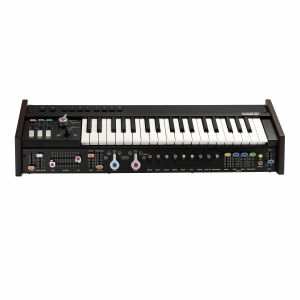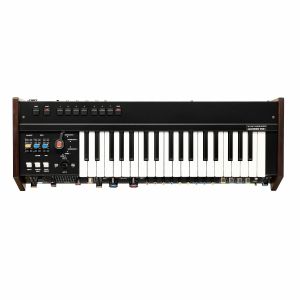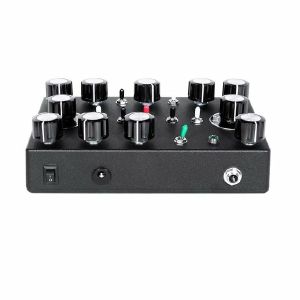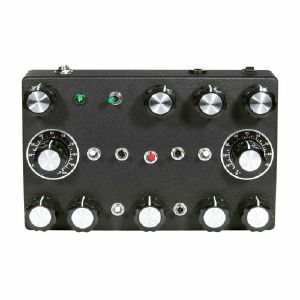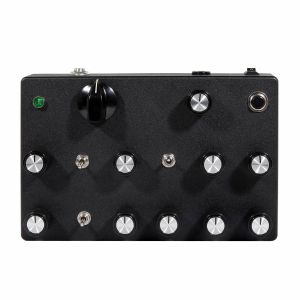Filter
Coming Soon
Equipment
Format
Brand
Featured
Price
Items 1 to 3 of 3 on page 1 of 1
Korg miniKORG 700Sm 37-Key Analogue Synthesiser (analogue keyboard synthesiser)
Cat: 1066370 Rel: 22 May 25
A compact tribute to the iconic miniKORG 700, the very origin of Korg's analogue synth history, enhanced to meet the needs of today's musicians
Notes: A contemporary reboot of the 1970s miniKORG 700, the 700Sm introduces a second oscillator, MIDI, arpeggiator and spring reverb. All the features of 2021's limited-edition 700FS reboot in a more compact, portable package.
Supplier's Notes:
The miniKORG 700Sm is a compact tribute to the iconic miniKORG 700, the very origin of Korg's analogue synth history, enhanced to meet the needs of today's musicians. Featuring two oscillators for thick, detuned sounds, the miniKORG 700Sm sees the return of the signature Traveler controller, allowing for expressive filter adjustments. With advancements like aftertouch, spring reverb, an arpeggiator, and a range of connectivity options including USB and MIDI, this synth is both a powerful standalone instrument and an excellent companion to stage keyboards. Complete with a custom soft case and a free software bundle, the miniKORG 700Sm brings vintage analogue sound into the present day.
Released in 2021, the miniKORG 700FS was a spectacular recreation of the legendary 1970s miniKORG 700S analogue synthesizer, enhanced with additional functionality that wasn't possible in the original. The miniKORG 700FS was so popular that its limited production run sold out quickly, with significant demand for increased production. Korg has a long history of groundbreaking analogue synthesizers. The miniKORG 700Sm is a tribute to the miniKORG 700, the very origin of Korg's analogue synth history, while being enhanced to meet the needs of today's musicians.
Downsizing the miniKORG 700FS
The miniKORG 700Sm retains all the features of the miniKORG 700FS in an instrument approximately 86% the size of the original. Additionally, the miniKORG 700Sm weighs just 5.8 kg (12.8 lbs), making it easy to transport.
The elements vital to an analogue synth
The character and richness of the sounds produced by the miniKORG 700 could not be realized through analogue modelling. Although it's possible to replicate a circuit by using the same parts and copying the design schematics or circuit board, there's no guarantee that this will reproduce the original sound. This is because the components age over time, dramatically altering the sound. To accurately recreate the original sound, Korg had to rely on the experience and skill of the technicians who worked on the original product.
Korg were able to bring the original sound to life thanks to their team of technicians, who have gained invaluable expertise over the years through their work on numerous synthesizer revival projects. This team was guided by the legendary Fumio Mieda, a Korg engineer since the early 1970s and one of the designers of the original miniKORG 700S. Working closely with Korg's sound designers, they meticulously reproduced the original sound as faithfully as possible. Those who play the miniKORG 700Sm will experience it as a beautifully crafted and authentic recreation of the original.
Beautiful synth leads, thick bass - and more
The miniKORG 700 was Korg's first synthesizer, and produced some of the most recognizable, rich and fattest analogue sounds of the time. The new miniKORG 700Sm features oscillators with an unmistakeable tone and an authentic recreation of the Traveler controller- a signature element of the miniKORG 700- designed to add extraordinary colour and expression to performances. Its sound fits seamlessly in today's music, especially with its standout lead and bass synth tones.
Secondary keyboard possibilities
The miniKORG 700 was originally designed as a secondary keyboard, often placed on top of an organ to expand their sound palette. The miniKORG 700Sm, with its compact and portable form factor, stands out as a powerful solo instrument but also complements stage keyboards like electric pianos and organs perfectly.
The controls on the miniKORG 700 were laid out below its keys in a row, allowing players to easily access them when it was placed on top of another instrument. This intuitive layout remains unchanged, offering simplicity, ease of use, and a unique look that sets it apart from any other instrument.
Expanded functionality When the miniKORG 700 was originally released, electronic components were larger in size, limiting functionality due to the small space inside. Thanks to advancements in technology, there is now room to include a spring reverb as well as a joystick for pitch bend and modulation. The new version also features aftertouch for added expressiveness, as well as an arpeggiator, USB port, MIDI IN connector and a CV/GATE IN jack. Korg have also added memory programs to store settings, something that wasn't available in the early 1970s.
Traveler controller
A unique feature of the miniKORG 700, the Traveler controller, consisted of two parallel sliders located below the keyboard. With these controls, players could adjust the cutoff frequency, with the upper lever controlling the low-pass filter and the lower lever controlling the high-pass filter. This gave players the freedom to adjust the expressive character of the sound according to the position of the levers. By moving the levers to the left and right while playing the keys, wah-wah and muted sounds could be created along with the iconic "traveling" sound.
Since the sound passing through the filter has a lower cutoff frequency and higher cutoff frequency than the frequencies set by the sliders, all frequencies are filtered and thus no sound is heard when the positions of the two sliders are inverted. In other words, making the two sliders cross would in theory produce no sound. To address this, the original miniKORG 700 featured protrusions on the sliders to physically prevent them from crossing.
The design was both a benefit and limitation of analogue circuitry. In the past- and even today- it's impossible to design a filter with perfect characteristics. During the time that the miniKORG 700 was sold, some players would shave off the protrusions on the sliders to allow them to cross, in an attempt to create new sounds. In fact, some models sold internationally did not even have the protrusions to begin with. The miniKORG 700Sm also does not have the protrusions, opening endless sound design possibilities and allowing players to create patches in unique ways.
A second oscillator The miniKORG 700 was a single-oscillator mono synth. One year later 1974, the miniKORG 700S was released with more space added to the left of the keyboard for a controller. This version also introduced a second oscillator, a ring modulator, and other enhancements. The new Sm model is a revival of the 700S, with its expanded functionality, including two oscillators that deliver powerful detuning and thick, penetrating sounds, particularly for bass and lead sounds.
Includes a made-to-fit soft case
The miniKORG 700Sm comes with a custom-made soft case designed to perfectly fit the instrument, ensuring both protection and portability. This case makes it easy to take your miniKORG 700Sm wherever you go, whether you're performing, recording, or traveling, keeping your synth safe and secure.
Free music software bundle
The miniKORG 700Sm comes with a diverse variety of music software including Izotope (featuring "Ozone Elements" which lets you not only create songs but also master them using AI), "Skoove" which will help you improve your keyboard playing skills, "miniKORG 700S" from the Korg Collection software, as well as a wide range of software synths from Korg and other developers.
Specifications
Keyboard: 37 keys (Slim-key, with aftertouch, no velocity sensitivity)
Range: 7 octaves
Waveform: Triangle wave, Square wave, Sawtooth wave, Chorus I, Chorus II
Programs: 14
Input: USB connector (Type B), MIDI IN connector, SYNC IN and SYNC OUT jack (3.5mm monaural mini phone jack), CV IN and GATE IN jack (3.5mm monaural mini phone jack), AUDIO IN jack (6.3mm monaural phone jack, TS unbalanced)
Output: OUTPUT L/MONO and R jack (6.3mm stereo phone jack, TS unbalanced), Headphones jack (6.3mm stereo phone jack)
Power supply: AC adapter (DC 12V)
Power consumption: 9W
Dimensions (W × D × H): 641 x 228 x 107 mm/25.24" x 8.98" x 4.21"
Weight: 5.8 kg/12.79 lbs.
Included items: AC adapter, Traveler knob (without protrusions type) x 2, Soft case Accessories (sold separately)
SQ-CABLE-6 (Patch Cable)
… Read moreSupplier's Notes:
The miniKORG 700Sm is a compact tribute to the iconic miniKORG 700, the very origin of Korg's analogue synth history, enhanced to meet the needs of today's musicians. Featuring two oscillators for thick, detuned sounds, the miniKORG 700Sm sees the return of the signature Traveler controller, allowing for expressive filter adjustments. With advancements like aftertouch, spring reverb, an arpeggiator, and a range of connectivity options including USB and MIDI, this synth is both a powerful standalone instrument and an excellent companion to stage keyboards. Complete with a custom soft case and a free software bundle, the miniKORG 700Sm brings vintage analogue sound into the present day.
Released in 2021, the miniKORG 700FS was a spectacular recreation of the legendary 1970s miniKORG 700S analogue synthesizer, enhanced with additional functionality that wasn't possible in the original. The miniKORG 700FS was so popular that its limited production run sold out quickly, with significant demand for increased production. Korg has a long history of groundbreaking analogue synthesizers. The miniKORG 700Sm is a tribute to the miniKORG 700, the very origin of Korg's analogue synth history, while being enhanced to meet the needs of today's musicians.
Downsizing the miniKORG 700FS
The miniKORG 700Sm retains all the features of the miniKORG 700FS in an instrument approximately 86% the size of the original. Additionally, the miniKORG 700Sm weighs just 5.8 kg (12.8 lbs), making it easy to transport.
The elements vital to an analogue synth
The character and richness of the sounds produced by the miniKORG 700 could not be realized through analogue modelling. Although it's possible to replicate a circuit by using the same parts and copying the design schematics or circuit board, there's no guarantee that this will reproduce the original sound. This is because the components age over time, dramatically altering the sound. To accurately recreate the original sound, Korg had to rely on the experience and skill of the technicians who worked on the original product.
Korg were able to bring the original sound to life thanks to their team of technicians, who have gained invaluable expertise over the years through their work on numerous synthesizer revival projects. This team was guided by the legendary Fumio Mieda, a Korg engineer since the early 1970s and one of the designers of the original miniKORG 700S. Working closely with Korg's sound designers, they meticulously reproduced the original sound as faithfully as possible. Those who play the miniKORG 700Sm will experience it as a beautifully crafted and authentic recreation of the original.
Beautiful synth leads, thick bass - and more
The miniKORG 700 was Korg's first synthesizer, and produced some of the most recognizable, rich and fattest analogue sounds of the time. The new miniKORG 700Sm features oscillators with an unmistakeable tone and an authentic recreation of the Traveler controller- a signature element of the miniKORG 700- designed to add extraordinary colour and expression to performances. Its sound fits seamlessly in today's music, especially with its standout lead and bass synth tones.
Secondary keyboard possibilities
The miniKORG 700 was originally designed as a secondary keyboard, often placed on top of an organ to expand their sound palette. The miniKORG 700Sm, with its compact and portable form factor, stands out as a powerful solo instrument but also complements stage keyboards like electric pianos and organs perfectly.
The controls on the miniKORG 700 were laid out below its keys in a row, allowing players to easily access them when it was placed on top of another instrument. This intuitive layout remains unchanged, offering simplicity, ease of use, and a unique look that sets it apart from any other instrument.
Expanded functionality When the miniKORG 700 was originally released, electronic components were larger in size, limiting functionality due to the small space inside. Thanks to advancements in technology, there is now room to include a spring reverb as well as a joystick for pitch bend and modulation. The new version also features aftertouch for added expressiveness, as well as an arpeggiator, USB port, MIDI IN connector and a CV/GATE IN jack. Korg have also added memory programs to store settings, something that wasn't available in the early 1970s.
Traveler controller
A unique feature of the miniKORG 700, the Traveler controller, consisted of two parallel sliders located below the keyboard. With these controls, players could adjust the cutoff frequency, with the upper lever controlling the low-pass filter and the lower lever controlling the high-pass filter. This gave players the freedom to adjust the expressive character of the sound according to the position of the levers. By moving the levers to the left and right while playing the keys, wah-wah and muted sounds could be created along with the iconic "traveling" sound.
Since the sound passing through the filter has a lower cutoff frequency and higher cutoff frequency than the frequencies set by the sliders, all frequencies are filtered and thus no sound is heard when the positions of the two sliders are inverted. In other words, making the two sliders cross would in theory produce no sound. To address this, the original miniKORG 700 featured protrusions on the sliders to physically prevent them from crossing.
The design was both a benefit and limitation of analogue circuitry. In the past- and even today- it's impossible to design a filter with perfect characteristics. During the time that the miniKORG 700 was sold, some players would shave off the protrusions on the sliders to allow them to cross, in an attempt to create new sounds. In fact, some models sold internationally did not even have the protrusions to begin with. The miniKORG 700Sm also does not have the protrusions, opening endless sound design possibilities and allowing players to create patches in unique ways.
A second oscillator The miniKORG 700 was a single-oscillator mono synth. One year later 1974, the miniKORG 700S was released with more space added to the left of the keyboard for a controller. This version also introduced a second oscillator, a ring modulator, and other enhancements. The new Sm model is a revival of the 700S, with its expanded functionality, including two oscillators that deliver powerful detuning and thick, penetrating sounds, particularly for bass and lead sounds.
Includes a made-to-fit soft case
The miniKORG 700Sm comes with a custom-made soft case designed to perfectly fit the instrument, ensuring both protection and portability. This case makes it easy to take your miniKORG 700Sm wherever you go, whether you're performing, recording, or traveling, keeping your synth safe and secure.
Free music software bundle
The miniKORG 700Sm comes with a diverse variety of music software including Izotope (featuring "Ozone Elements" which lets you not only create songs but also master them using AI), "Skoove" which will help you improve your keyboard playing skills, "miniKORG 700S" from the Korg Collection software, as well as a wide range of software synths from Korg and other developers.
Specifications
Keyboard: 37 keys (Slim-key, with aftertouch, no velocity sensitivity)
Range: 7 octaves
Waveform: Triangle wave, Square wave, Sawtooth wave, Chorus I, Chorus II
Programs: 14
Input: USB connector (Type B), MIDI IN connector, SYNC IN and SYNC OUT jack (3.5mm monaural mini phone jack), CV IN and GATE IN jack (3.5mm monaural mini phone jack), AUDIO IN jack (6.3mm monaural phone jack, TS unbalanced)
Output: OUTPUT L/MONO and R jack (6.3mm stereo phone jack, TS unbalanced), Headphones jack (6.3mm stereo phone jack)
Power supply: AC adapter (DC 12V)
Power consumption: 9W
Dimensions (W × D × H): 641 x 228 x 107 mm/25.24" x 8.98" x 4.21"
Weight: 5.8 kg/12.79 lbs.
Included items: AC adapter, Traveler knob (without protrusions type) x 2, Soft case Accessories (sold separately)
SQ-CABLE-6 (Patch Cable)
2 in stock $1,304.74
Click for better price!
or call +44 20 7424 1960
quote 1066370
quote 1066370
JMT Synth UNVO-1 Analogue Desktop Synthesiser (analogue desktop synthesiser)
Cat: 1060996 Rel: 21 May 25
Analogue desktop noise synthesiser
Notes: It is powered by a center negative DC 9V adapter or a single 9V battery.
It contains two VCOs (oscillators) with a wide range.
The SUB oscillator has a different frequency and waveform, and is input to the main, respectively. Each of them has a range switch, so it works like an LFO under the switch. The color of the range switch (white, black) corresponds to the color of the SUB.1 and SUB.2 on-off switches next to the FREQ knob of the main oscillator.
When the WAVE switch is turned on, the WAVE knob is activated, and the SUB OSCILLATOR.1 and 2 are shaken.
The main VCO×2 is mixed and fed into the strain + filter circuit. This special filter has a FREQ knob and a TUNE knob. The TUNE knob powerfully amplifies the input signal while also tracking specific pronunciations.
The filter is a circuit that has been fine-tuned so that it can very effectively enhance the bass and treble of this input signal.
Unlike other switches, the noise-on switch moves sideways, left (VCO.1), middle (OFF), and right (VCO.2). They are populated in VCO.1 and 2, respectively.
It is a noise machine that can output a very strong signal that generates a variety of noise sounds.
This analogue synth runs on DC9V negative center or a 9V battery.
The main 2 VCOs can receive 2 oscillators and noise generator inside and go to 2 different filters.
2 oscillators can be tuned with each two FREQ. knobs and controlled with the wave knob.
RED switch is for wave knob working.
Black and White for tone of oscillators
… Read moreIt contains two VCOs (oscillators) with a wide range.
The SUB oscillator has a different frequency and waveform, and is input to the main, respectively. Each of them has a range switch, so it works like an LFO under the switch. The color of the range switch (white, black) corresponds to the color of the SUB.1 and SUB.2 on-off switches next to the FREQ knob of the main oscillator.
When the WAVE switch is turned on, the WAVE knob is activated, and the SUB OSCILLATOR.1 and 2 are shaken.
The main VCO×2 is mixed and fed into the strain + filter circuit. This special filter has a FREQ knob and a TUNE knob. The TUNE knob powerfully amplifies the input signal while also tracking specific pronunciations.
The filter is a circuit that has been fine-tuned so that it can very effectively enhance the bass and treble of this input signal.
Unlike other switches, the noise-on switch moves sideways, left (VCO.1), middle (OFF), and right (VCO.2). They are populated in VCO.1 and 2, respectively.
It is a noise machine that can output a very strong signal that generates a variety of noise sounds.
This analogue synth runs on DC9V negative center or a 9V battery.
The main 2 VCOs can receive 2 oscillators and noise generator inside and go to 2 different filters.
2 oscillators can be tuned with each two FREQ. knobs and controlled with the wave knob.
RED switch is for wave knob working.
Black and White for tone of oscillators
1 in stock $299.44
Click for better price!
or call +44 20 7424 1960
quote 1060996
quote 1060996
JMT Synth EGL-1 Analogue Desktop Synthesiser (analogue desktop synthesiser)
Cat: 1061069 Rel: 21 May 25
EGL-1 is a desktop analogue synthesiser that is ideal for a variety of duties; modulation capabailties, VCO routed through a boost circuit and much more
Notes: EGL-1 is a desktop analogue synthesiser that is ideal for a variety of duties. The unit's sub-oscillator can be configured to determine the emitted waveform and decays when the Push switch is pressed. There are four LFOs routed to the primary VCO for bountiful modulation capabilities. The VCO itself is routed through a boost circuit for a some extra flair that's sure to punish listeners in all the right ways.
EGL-1 Features
VCO routed through boost circuit
4 LFOs provide ample modulation possibilities
Integrated sub-oscillator
Push switch causes the sub-oscillator to decay
Two types of modulation can be applied to the MAIN VCO (oscillator).
The bottom stage mixes four LFOs and allows you to adjust the input level to the MAIN VCO with the level.
The middle stage allows you to input a WAVE to the SUB OSC (another oscillator) with adjustable rise and fall of the oscillator, which can then be fed into the MAIN VCO.
The push-button in the top right-hand corner rapidly decays the power of the SUB OSC as long as it is pressed. While it decays, it has an effect on the sound of the MAIN VCO.
The MAIN VCO output also has an output circuit to make the sound more powerful.
The EGL-1 operates from a 9V centre-minus or battery. Neither is included.
… Read moreEGL-1 Features
VCO routed through boost circuit
4 LFOs provide ample modulation possibilities
Integrated sub-oscillator
Push switch causes the sub-oscillator to decay
Two types of modulation can be applied to the MAIN VCO (oscillator).
The bottom stage mixes four LFOs and allows you to adjust the input level to the MAIN VCO with the level.
The middle stage allows you to input a WAVE to the SUB OSC (another oscillator) with adjustable rise and fall of the oscillator, which can then be fed into the MAIN VCO.
The push-button in the top right-hand corner rapidly decays the power of the SUB OSC as long as it is pressed. While it decays, it has an effect on the sound of the MAIN VCO.
The MAIN VCO output also has an output circuit to make the sound more powerful.
The EGL-1 operates from a 9V centre-minus or battery. Neither is included.
1 in stock $255.54
Click for better price!
or call +44 20 7424 1960
quote 1061069
quote 1061069
Items 1 to 3 of 3 on page 1 of 1

 USD
USD







